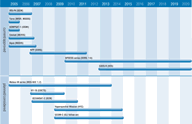Ocean colour/biology
Remote sensing measurements of ocean colour (ie the detection of phytoplankton pigments) provide the only global-scale focus on the biology and productivity of the ocean’s surface layer. Phytoplankton are microscopic plants that live in the ocean, and like terrestrial plants, they contain the pigment chlorophyll, which gives them their greenish colour. Different shades of ocean colour reveal the presence of differing concentrations of sediments, organic materials and phytoplankton. The ocean over regions with high concentrations of phytoplankton will appear as certain shades, from blue-green to green, depending on the type and density of the phytoplankton population there. From space, satellite sensors can distinguish even slight variations in colour, to which the human eye is not sensitive.
Ocean biology is important not only for understanding ocean productivity and biogeochemical cycling, but also because of its impact on oceanic CO2 and the flux of carbon from the surface to the deep ocean. Over time, organic carbon settles in the deep ocean - a process referred to as the ‘biological pump’. CO2 system measurements, integrated with routine ocean colour and ecological/biogeochemical observations, are critical for understanding of the interactions between oceanic physics, biology, chemistry and climate. CO2 measurements are also important for making climate forecasts, and for satisfying the needs of climate conventions.
At a local scale, satellite observations of ocean colour, usually in conjunction with sea surface temperature measurements, may be used as an indication of the presence of fish stocks. Measurements may also be used to monitor water quality and to give an indication of the presence of pollution by identifying algal blooms. Measurements of ocean colour are particularly important in coastal regions where they can be used to identify features indicative of coastal erosion and sediment transfer.
IGOS set up an Ocean Theme in 1999 to develop a strategy for an observing system serving research and operational oceanographic communities and other users. Building on the CEOS Ocean Biology and GODAE Projects, the Ocean Theme Team published its final report in January 2001 - available from www.igospartners.org.
This brought together information on:
- the variety of needs for global ocean observations;
- the existing and planned observing systems;
- the planning commitments required to ensure long-term continuity of the observations.
In recent years there has been a steady flow of ocean colour data from instruments such as OCTS, SeaWiFs, OCM, MODIS, and MERIS. As the timeline shows, a number of current missions will end in the near future. Information available on agency plans indicate that future continuity may be provided by Oceansat-2 (India), HY-1C (China) and others.
Beyond these research missions, NOAA is developing VIIRS for its NPOESS missions. A visible/infrared sensor, VIIRS will have an operational capability for ocean colour observations and a variety of derived ocean colour products. The NPOESS preparatory programme will deploy prototypes of VIIRS in the 2006-2007 time frame.

